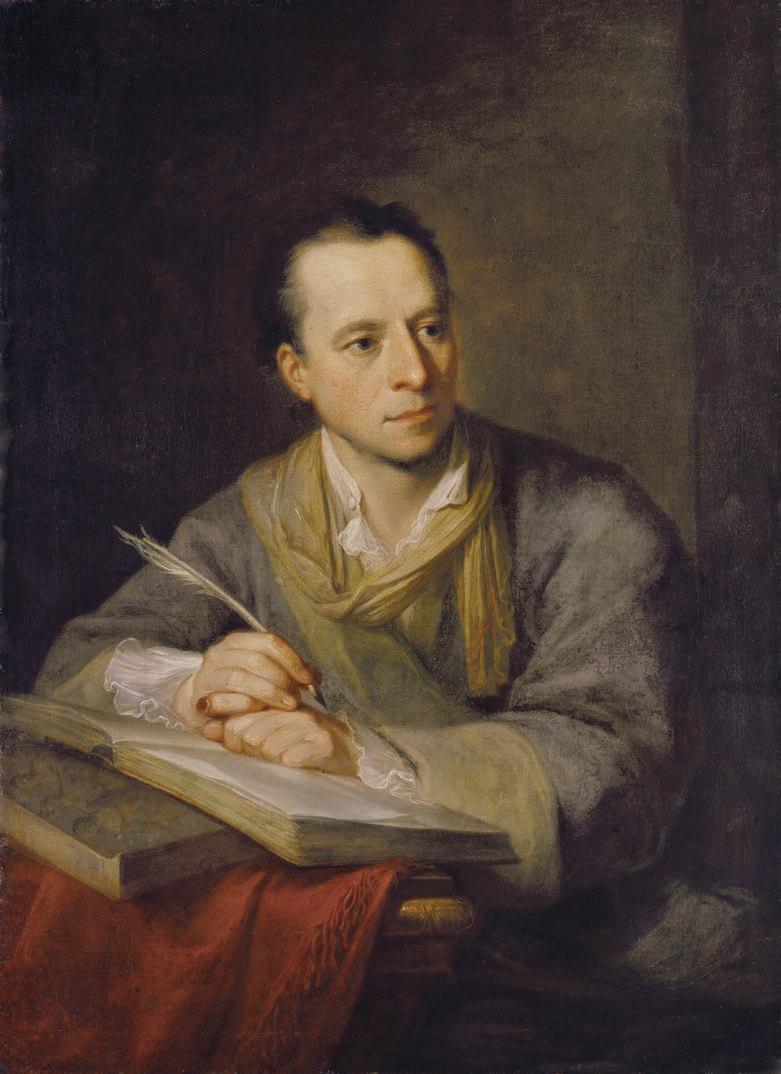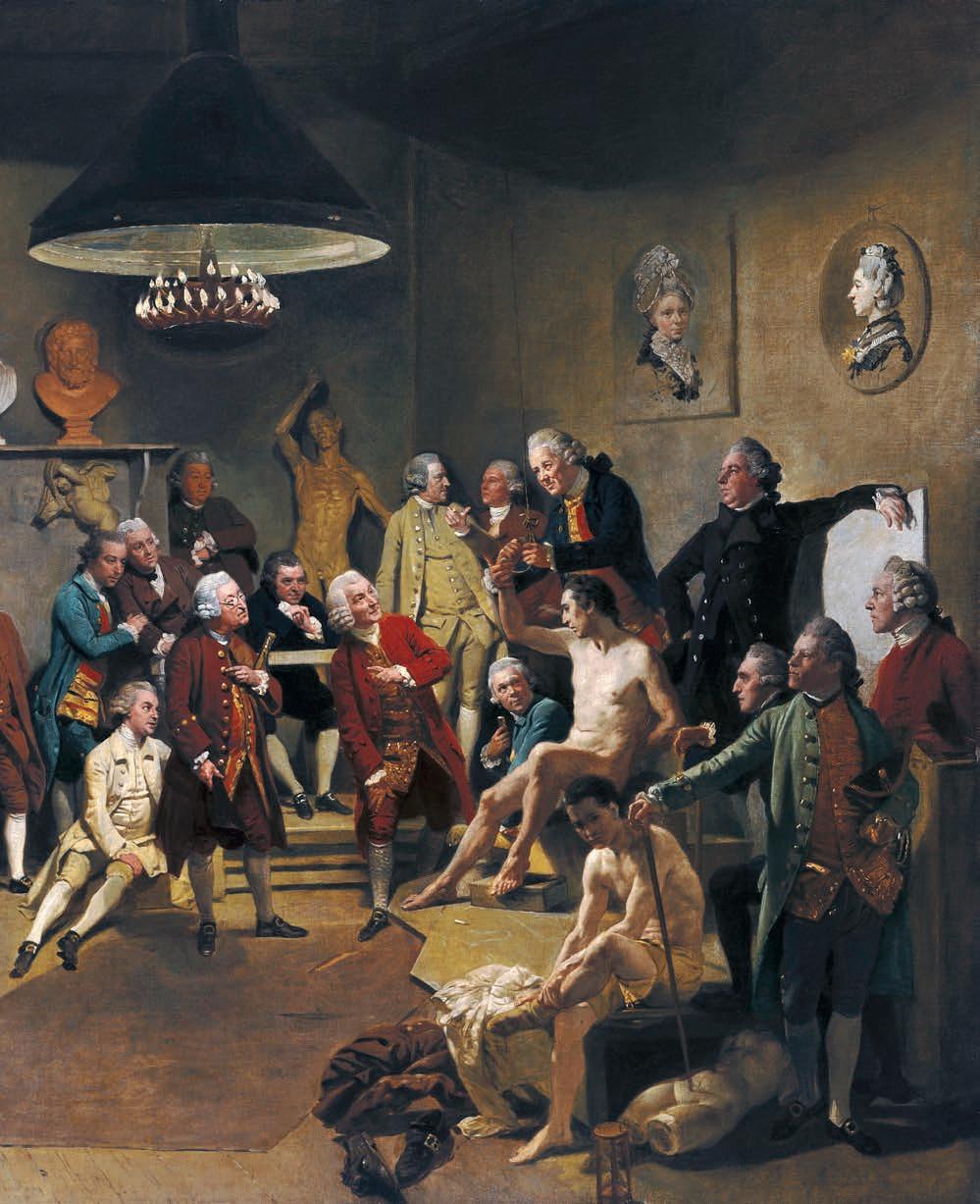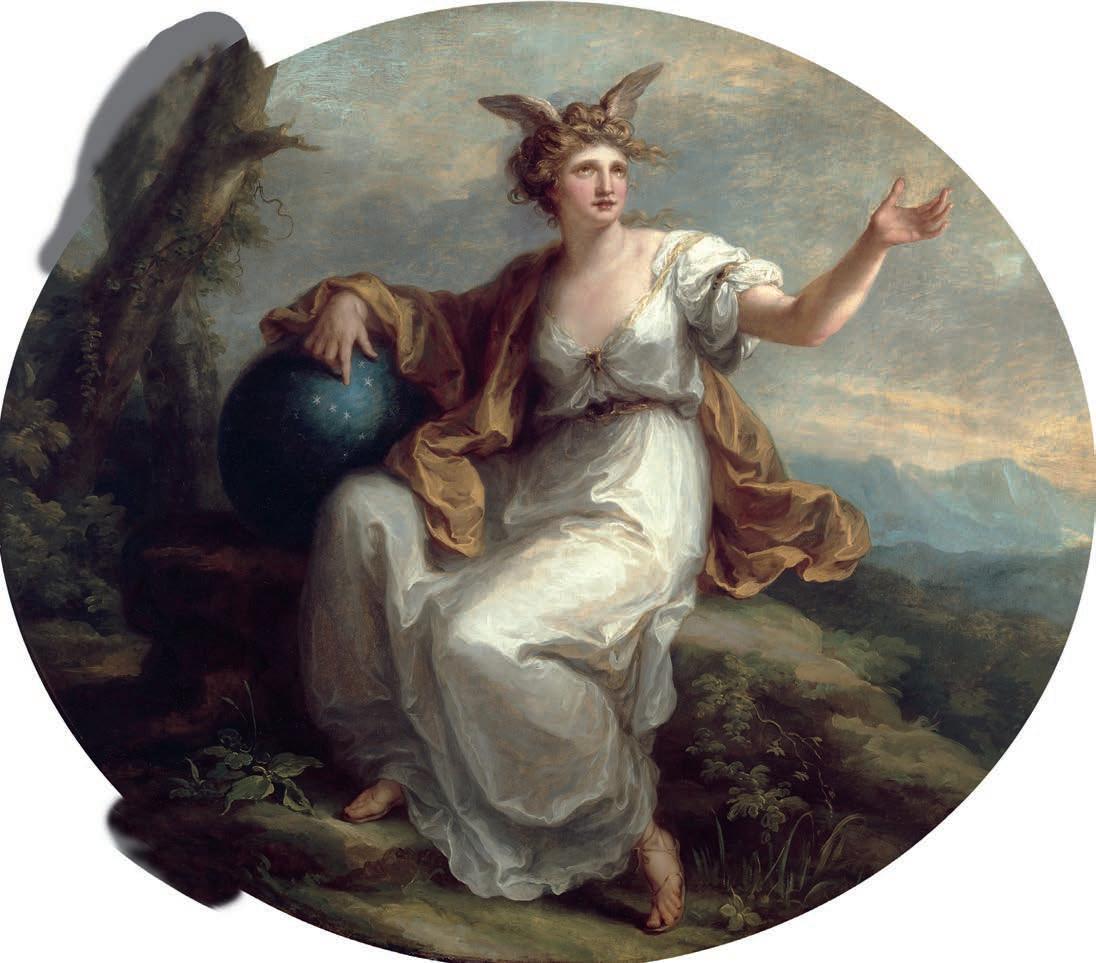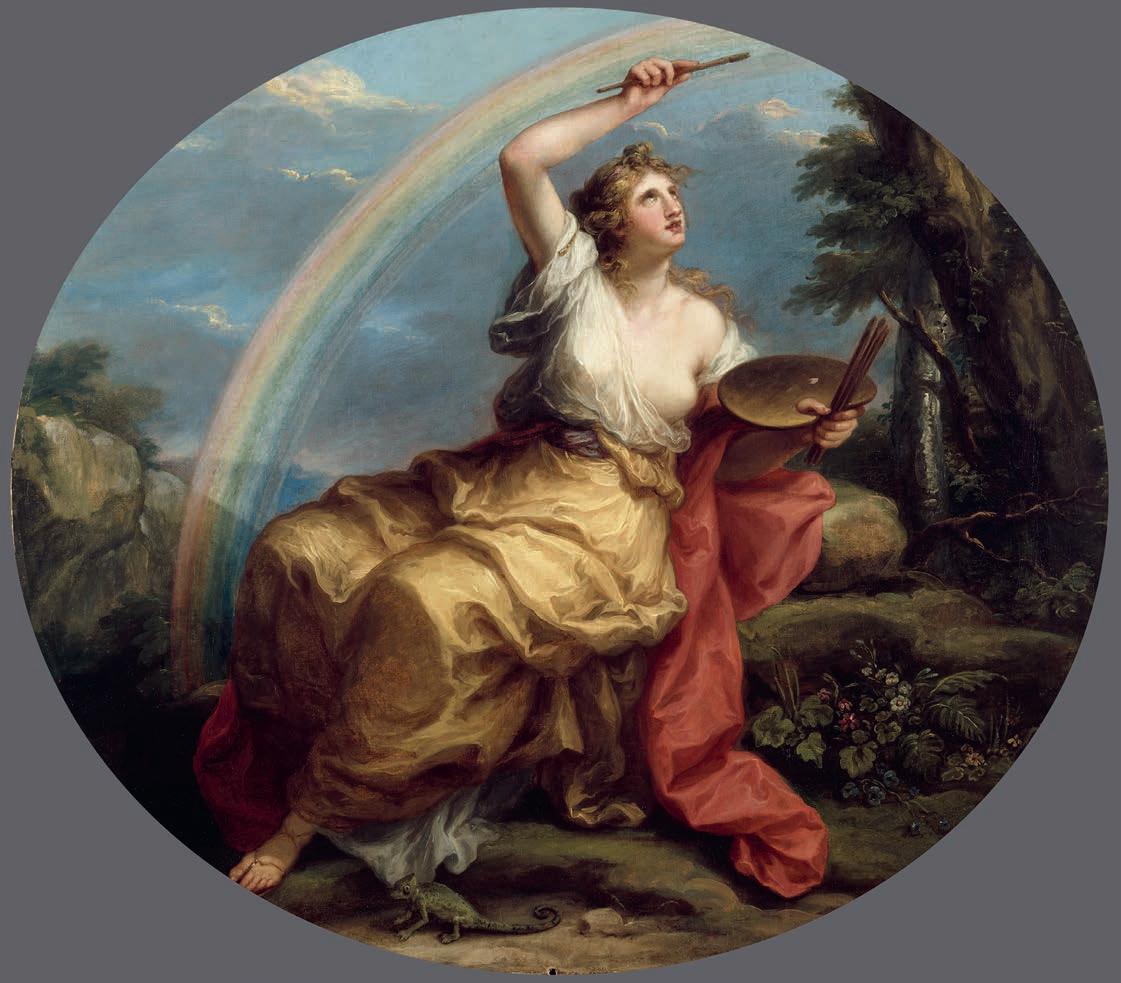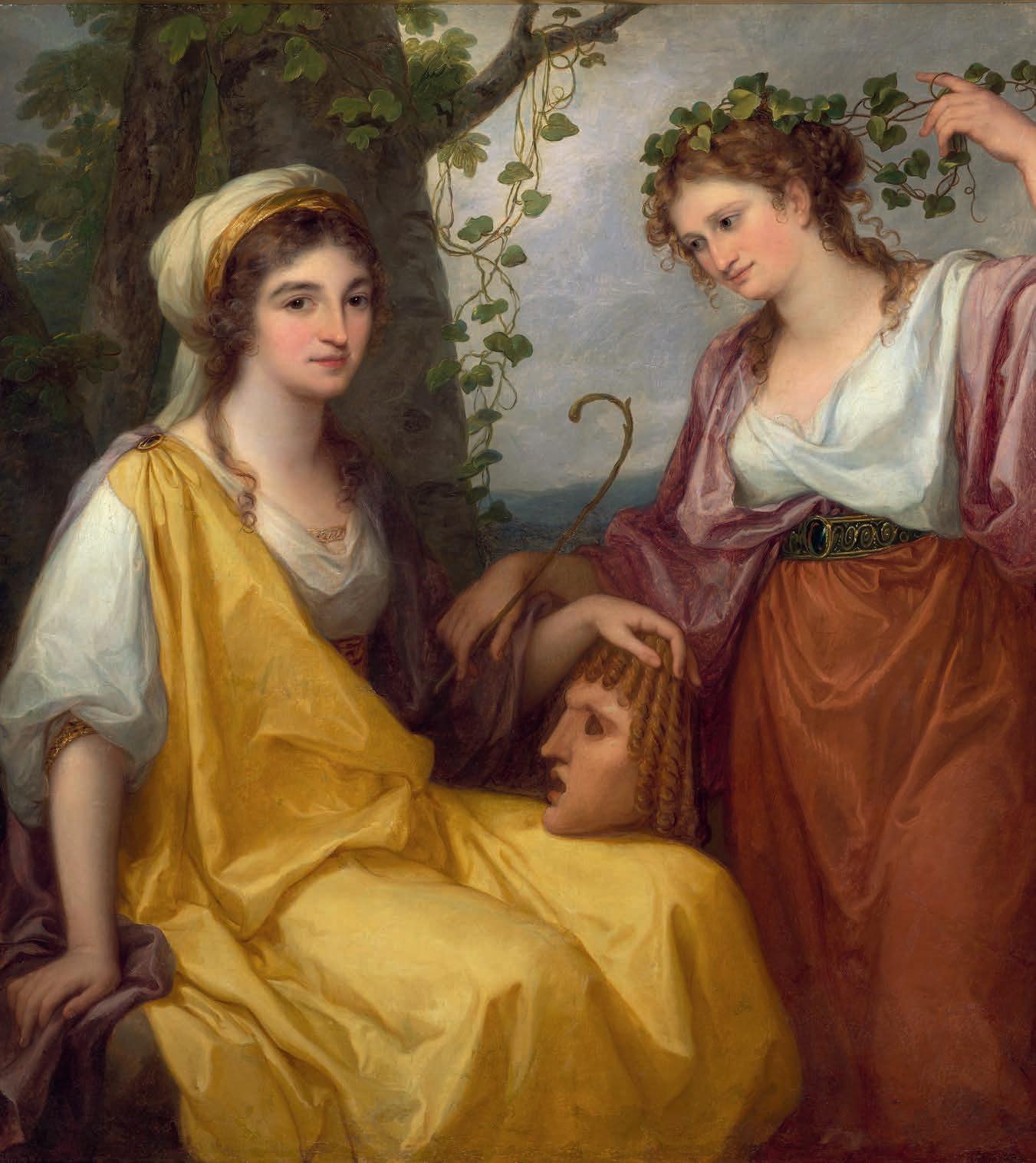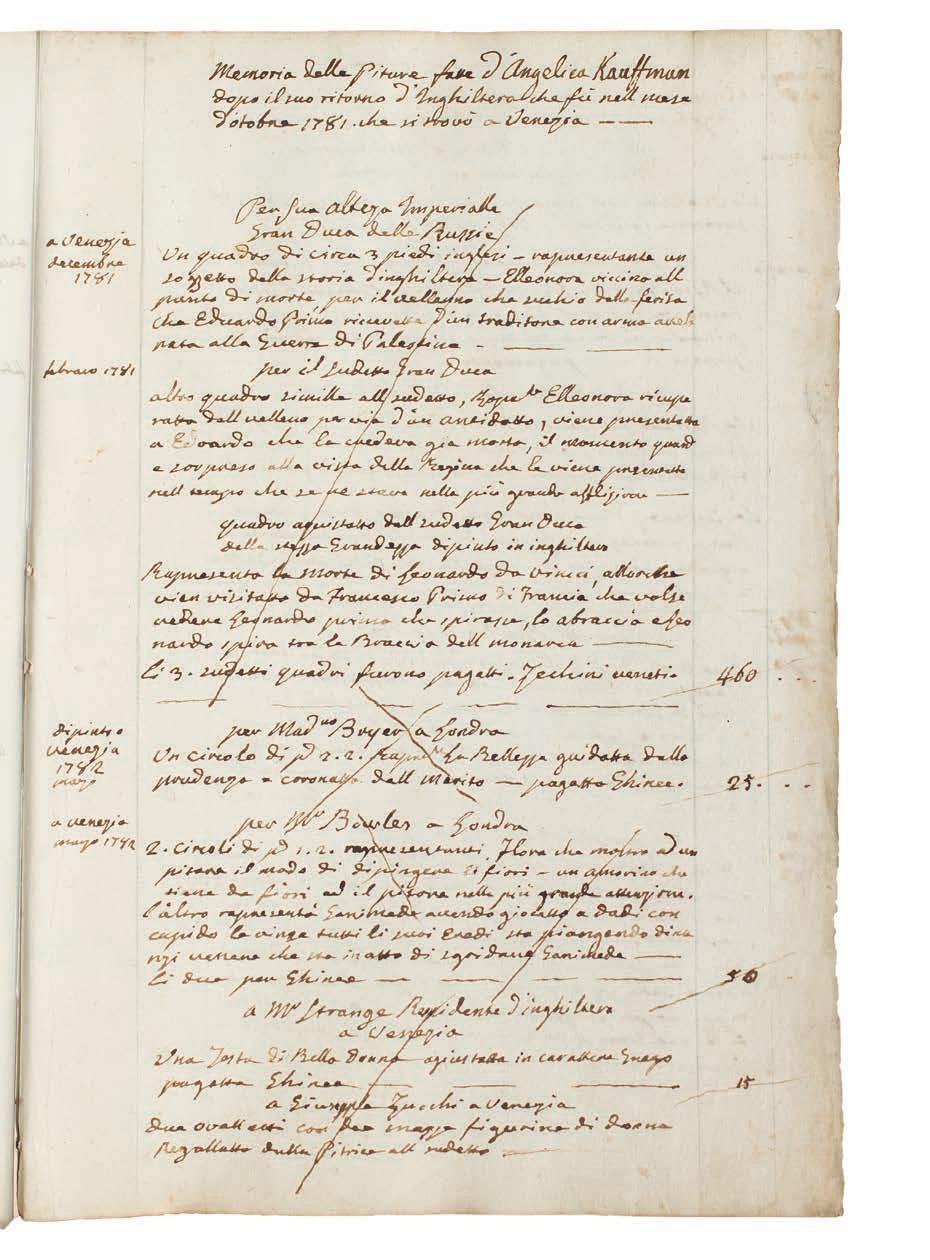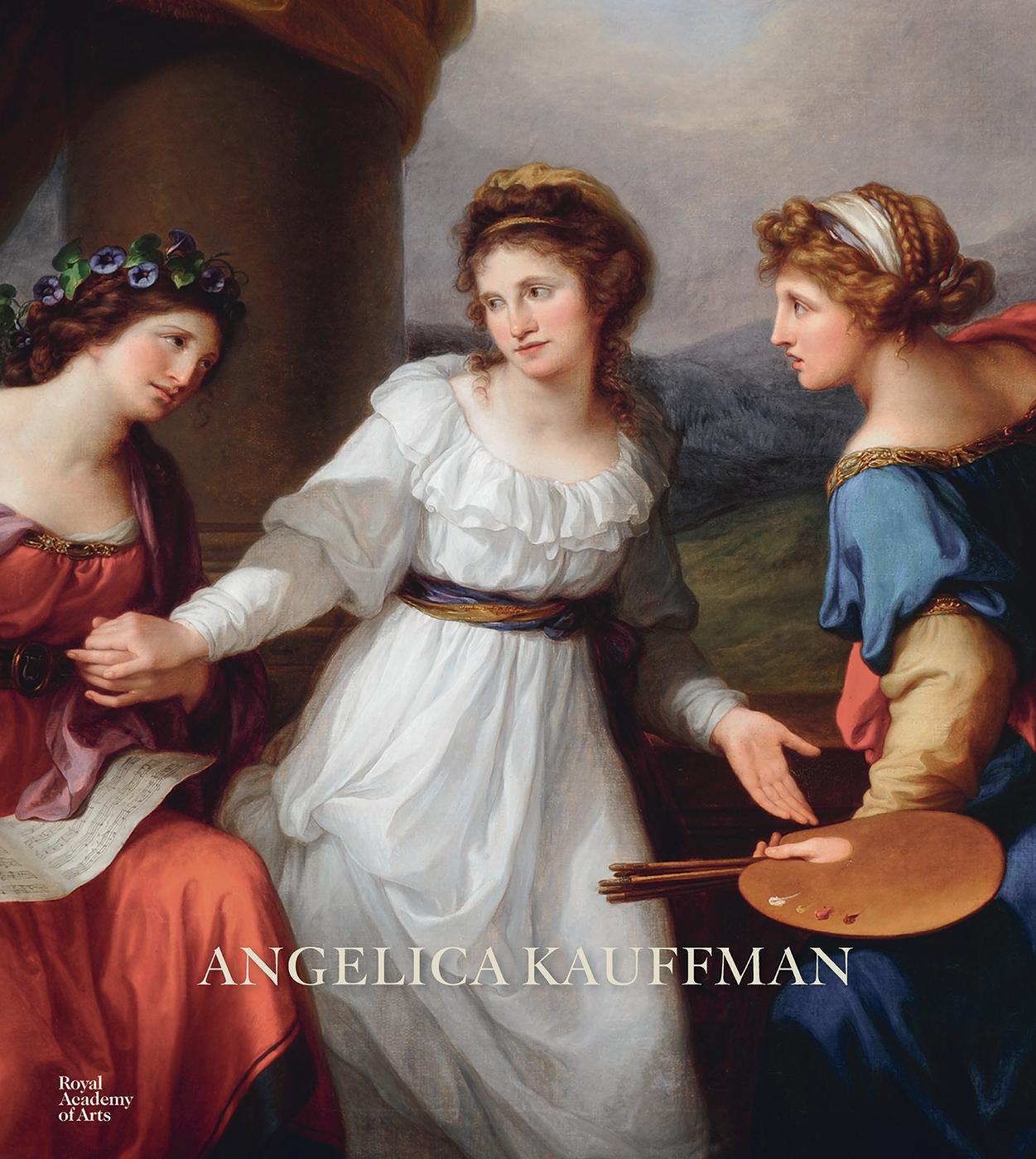
First published on the occasion of the exhibition
‘Angelica Kauffman’
Royal Academy of Arts, London
1 March – 30 June 2024
Supported by Christian Levett and Musée FAMM, with additional support from Kathryn Uhde, Antigone Theodorou and Stefan Bollinger, the Glenbevan Trust, the International Music and Art Foundation, Miss Rosemary Lomax-Simpson, and the Dr Lee MacCormick Edwards Charitable Foundation
This exhibition has been made possible as a result of the Government Indemnity Scheme. The Royal Academy of Arts would like to thank HM Government for providing indemnity and the Department for Digital, Culture, Media & Sport and Arts Council England for arranging the indemnity.
director of exhibitions
Andrea Tarsia
exhibition curators
Bettina Baumgärtel
Per Rumberg
Annette Wickham
Rebecca Bray assisted by Natasha Fyffe
exhibition management
Joanna Weston with Helena Cooper
photographic and copyright co-ordination
Caroline Arno
Giulia Ariete
exhibition catalogue
Royal Academy Publications
Florence Dassonville, Production and Distribution Co-ordinator
Carola Krueger, Production and Distribution Manager
Peter Sawbridge, Head of Publishing and Editorial Director
Translation from the German (Baumgärtel): Fiona Elliott
Copy-editing and proofreading: Caroline Ellerby
Design: Maggi Smith
Colour origination and print: Gomer Press, Wales
Printed in Wales by Gomer
Copyright © 2024 Royal Academy of Arts, London
Text by Bettina Baumgärtel copyright © 2024, Bettina Baumgärtel
Any copy of this book issued by the publisher is sold subject to the condition that it shall not by way of trade or otherwise be lent, re-sold, hired out or otherwise circulated without the publisher’s prior consent in any form of binding or cover other than that in which it is published and without a similar condition including these words being imposed on a subsequent purchaser.
All Rights Reserved. No part of this publication may be reproduced or transmitted in any form or by any means, electronic or mechanical, including photocopy, recording or any other information storage and retrieval system, without prior permission in writing from the publisher.
British Library Cataloguing-in-Publication Data
A catalogue record for this book is available from the British Library
ISBN 978-1-915815-03-3
Distributed outside the United States and Canada by ACC Art Books Ltd, Riverside House, Dock Lane, Melton, Woodbridge, IP12 1PE
Distributed in the United States and Canada by ARTBOOK | D.A.P., 75 Broad Street, Suite 630, New York, NY 10004
editorial note
All works illustrated are by Angelica Kauffman (1741–1807) unless otherwise stated.
Dimensions of all works of art are given in centimetres, height before width.
illustrations
Pages 2–3: detail of p. 80
Page 7: detail of cat. 4
Page 9: detail of cat. 6
Pages 34–5: detail of cat. 31
‘she was of her time and the time was made for her’ 11 bettina baumgärtel
angelica kauffman and the royal academy 25 annette wickham
catalogue plates with section introductions by annette wickham staging the self
from italy to england
well before the French Revolution, she was already exploring a female perspective on bourgeois virtue in the Roman republic. She also created Greek counterparts to these courageous Roman women: exemplary figures such as Penelope and heroic lovers such as Dido, Circe (cat. 35), Calypso and Sappho took centre stage in her compositions and thus significantly contributed to the formation of a new Enlightenment ideal of femininity. In these compositions, bearing in mind Johann Joachim Winckelmann’s concept of ‘noble simplicity and serene grandeur’,46 Kauffman avoided extreme imagery and portrayed the fates of her heroines in carefully calibrated emotional situations. And her figures also have the flowing outlines of William Hogarth’s ‘line of beauty’.47 Although Kauffman adhered to the classicist rules of beauty, her art was frequently disparaged as work done by a woman. She had to withstand accusations that, as a woman, she lacked ‘masculine powers of expression’ and that her figures were debilitated due to feminisation. This dismissal of ‘art by women’ as genderdependent ‘women’s art’ has been commonplace ever since Giorgio Vasari published his Lives of the Most Excellent Painters, Sculptors, and Architects in 1550.48
Refined colourism
Close examination of Kauffman’s paintings reveals the full extent of her painterly virtuosity. She had a particular talent for depicting colours and textiles, which she executed with a penello volante – a flying brush – and very fluid paints in contrasting areas of extremely sparse application or striking impasto. Her saturated yet finely attuned colours recall the finest Baroque masters in northern Italy and southern Germany. Her agile brushwork bespeaks her musicality; indeed she had a positively Mozartean dexterity. In works such as Rinaldo and Armida in the Magic Garden (c. 1772;
cat. 9) echoes of French Rococo resonate in subtly tasteful, ‘ancient’ Classicism. As yet few are aware that Kauffman’s approach to painting was also an expression of a new aesthetic: it utilises ground-breaking findings concerning not only the perception of the relationship between light and shade (chiaroscuro) but also the impact of shimmering colours, as in the Royal Academy ceiling painting Colouring (1780; see p. 81). According to Joseph Baretti:
Colouring appears in the form of a blooming young Virgin, brilliantly, but not gaudily dressed. The varied Colours of her garments unite and harmonize together. In one hand she holds a prism, and in the other a brush, which she dips in the Tints of the Rainbow. Under her feet is seen the Cameleon sporting on a bed of various flowers.49
In fact her artistic practice partly informed the theories and aesthetics that were debated in the circle around Goethe, influencing his colour theory and also contributing to the idea of ‘changeant’ painting developed by Goethe’s friend, the Swiss artist and art historian Johann Heinrich Meyer.50 In her final years Kauffman returned to her early ‘Baroque classicist’ period. Close-quarters monumentality in her figuration and strong local colours mark the onset of her late religious works, such as Christ and the Samaritan Woman (1796; cat. 36). In conclusion it could be said that Kauffman’s strength lay in her virtuosic ability to combine aspects of Roman-Bolognese, Venetian, French and English styles in a highly sophisticated, sentimental and virtuously pathos-laden Classicism. In Kauffman’s rhapsodic natural scenarios, content and form – so often inspired by Antiquity – coalesce in an ideal image of exalted humanity.
Detail of Colouring, 1780 (see p. 81)
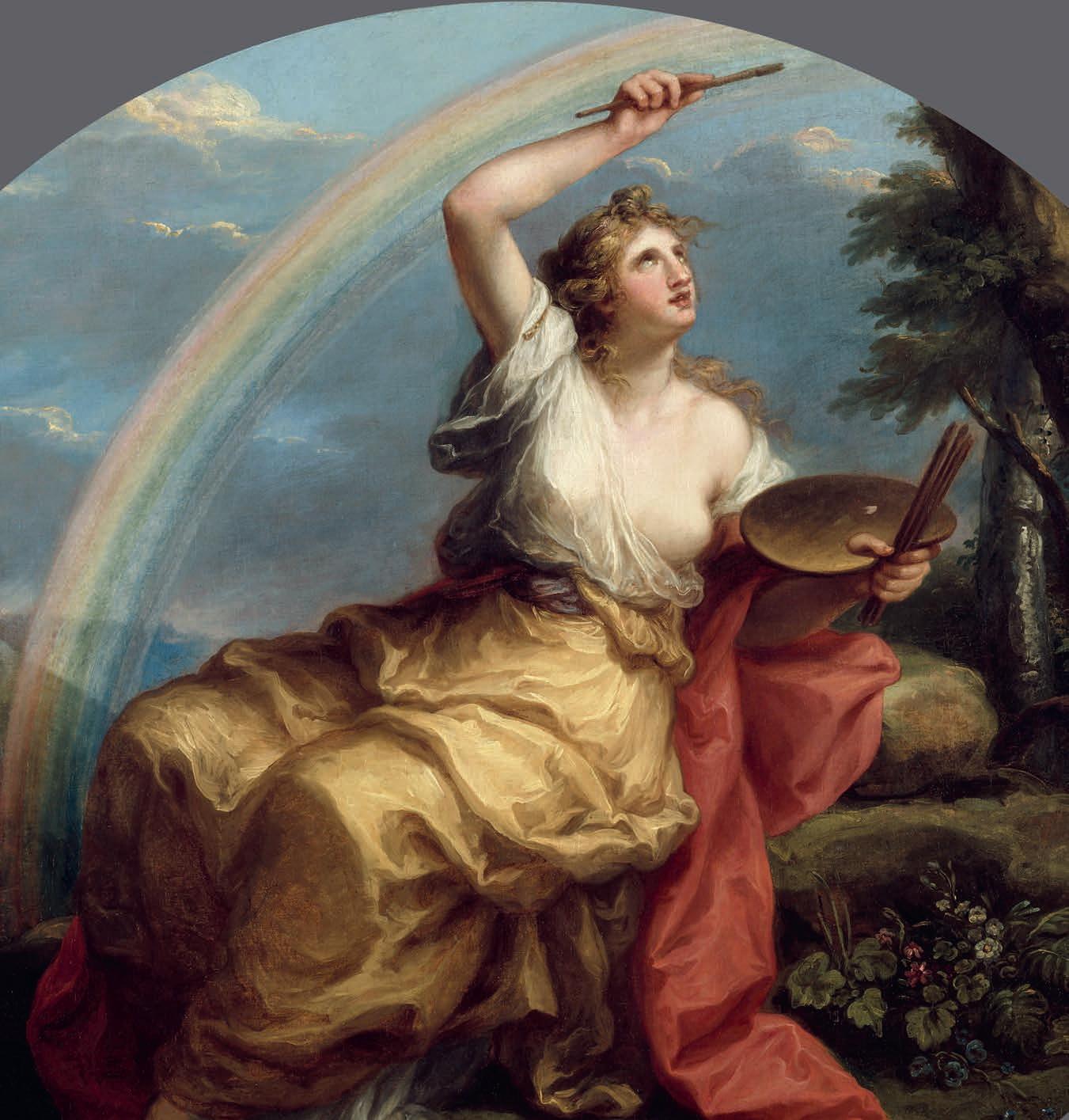
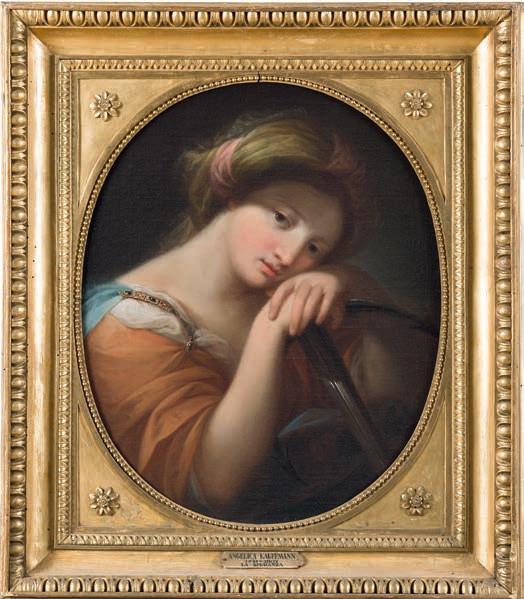
Chronicle observed, for example: ‘It is surely somewhat singular that while so many of our male artists are employed upon portraits, landscapes and the other inferior species of painting, this lady should be almost uniformly carried, by the boldness and sublimity of her genius, to venture upon historical pieces.’ 31 Her focus on female characters and domestic settings in her history paintings was also noted and generally interpreted by her contemporaries in terms of her ‘natural’ predisposition as a woman.32 This reading possibly aided her acceptance as a history painter, situating her work as a variant of the genre that did not encroach on the ‘male’ territory of more epic scenes. More recently, scholars have argued for a nuanced analysis of features such as the domesticity of Kauffman’s Odyssey scenes, suggesting that her compositions
‘mediate between the artist’s own subject position and the traditional forms of history painting’.33 Whereas her historical works broadly reinforce traditional ‘female’ virtues, Bettina Baumgärtel has demonstrated how Kauffman consistently portrayed active rather than passive heroines, and her insistence on incorporating women into public life and historical and literary discourse through her choice of subjects in itself challenged the status quo.34
Kauffman’s exceptional celebrity as a woman artist and a member of the Royal Academy did not come without a cost, however. In addition to gendered criticism, the flipside of her fame was a seam of gossip and innuendo.35 This took on tangible form at the Academy in 1775 when the Irish artist Nathaniel Hone (1718–1784) sent The Pictorial Conjuror, Displaying the Whole Art of Optical Deception (National Gallery of Ireland, Dublin) to the Annual Exhibition. The painting depicts an old man, with a girl at his knee, conjuring a picture from an array of old prints. The most obvious target was Reynolds – known for his liberal recycling of motifs from the Old Masters – but the girl’s pose also mimics Kauffman’s painting Hope (1765; fig. 13), which was issued as a print in England in February 1775.
More scurrilously, Hone included a group of naked artists in the background cavorting in front of St Paul’s Cathedral, one a woman holding a palette and wearing only black stockings which was thought to depict Kauffman herself. This mocked those artists – among them Kauffman and Reynolds – who were involved in a short-lived commission to paint the interiors of St Paul’s in 1773.36 Kauffman immediately took issue with this, and her subsequent letter to the Academy’s Council (cat. 38) suggests that, initially, they attempted to placate her without removing the painting.37 She was forced to exhort the Council to demonstrate ‘a Respect to the Sex which it is their glory to support’ and threatened to quit the Academy if they did not – ‘withdrawing one object who never deserved his or their ridicule’.38 Her warning shot prompted a ballot. The Royal Academicians voted in favour of Kauffman, and Hone was instructed to remove his painting.39 The saga rumbled on.
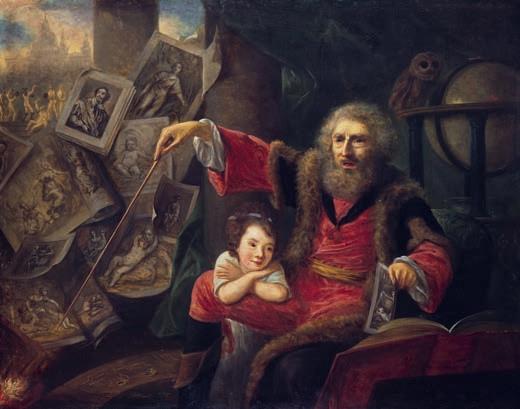
Hone insisted on exhibiting the work (with the naked figures transformed into a group of clothed gentlemen drinking wine at a table) in a one-man show, denying any intended slight on Kauffman.40 The offending scene can, however, still be seen in his preparatory oil sketch for the work (fig. 14).
Having successfully asserted herself at the Academy both through her art and against moral slights, Kauffman was at the height of her powers and popularity in England during the late 1770s. A much more respectful representation of her appeared on the Academy’s walls in the Annual Exhibition in 1779 in Richard Samuel’s Portraits in the Characters of the Muses in the Temple of Apollo (1778; cat. 19), in which she features as the only artist among a group of ‘bluestockings’, distinguished female musicians, writers and scholars. Although this was a speculative work, produced without the involvement of any of the women depicted, it was evidently intended as a positive portrayal and is, as Elizabeth Eger has noted, a unique example
of a ‘group portrait of women united by their professional status’ in Britain at this date.41 Rather than presenting the women as otherworldly conduits of inspiration to great men, she adds that Samuel painted them with ‘their feet firmly on the ground, demanding respect and provoking curiosity’.42 The same exhibition featured seven of Kauffman’s own paintings. Kauffman’s crowning accolade at the Academy, though, was the invitation to adorn the ceiling of one of its prestigious purpose-built apartments at New Somerset House, designed by Sir William Chambers, which were unveiled in 1780. The architectural and visual programme of the building has been described as fostering the sense of ‘an ascent to Parnassus’, leading the exhibition visitor up to the splendours of the Great Room.43 However, as Helen Valentine has argued, Kauffman’s works in the Royal Academicians’ Council Room – alongside those of Benjamin West and others – were primarily for an audience of her peers. As part of a decorative scheme casting the Academy as ‘collective arbiters of national taste… within their own palace of art’ this was therefore a particularly significant honour within the institution.44
The four oval panels depict Invention (see p. 80), Design (cat. 24), Composition (cat. 25) and Colouring (p. 81) and are together known as The Elements of Art (1780). How much Kauffman personally determined their subject matter is not known but the presence of four preparatory grisaille drawings (cats 20–23) with only minor differences from the finished compositions suggests a possible consultative process between the artist, Reynolds, Chambers and other Royal Academicians. Kauffman’s four cornerstones of art synthesise established academic art theory, referencing Reynolds, Johann Joachim Winckelmann, Jonathan Richardson and earlier writers. Bettina Baumgärtel has demonstrated that, in personifying all four as women, Kauffman deviates significantly from tradition, forging her own interpretation of the artistic process and visually identifying this with her own practice as an artist.45 Kauffman also directly references the Royal Academy context: Design draws the revered Belvedere Torso, two plaster casts of which were among the prized possessions of the early Royal
